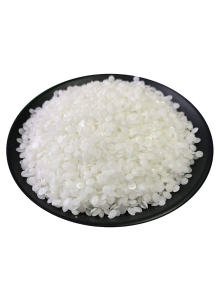Synthetic Wax (Medium, Melting Point 86C)
- Product Code: 32747
Synthetic wax (often referred to in a broad sense as paraffin wax) is typically a blend of long-chain hydrocarbons (alkanes)
Synthetic wax (often referred to in a broad sense as paraffin wax) is typically a blend of long-chain hydrocarbons (alkanes)
Synthetic Wax (Medium, Melting Point 86C)
1. Chemical Nature & Origin
- Definition: Synthetic wax (often referred to in a broad sense as paraffin wax) is typically a blend of long-chain hydrocarbons (alkanes).
- CAS Number: 8002-74-2 generally covers petroleum-derived paraffinic waxes.
- Production: Usually refined from crude oil or synthesized from other hydrocarbon processes.
2. Role in Cosmetic Formulations
-
Structuring Agent:
- Provides body and structure to formulations such as lip balms, lipsticks, and solid creams.
- Helps products maintain their shape and consistency at typical ambient temperatures.
-
Texture & Spreadability:
- Yields a creamier or softer texture upon application compared to harder waxes.
- Melts relatively easily at skin temperature, aiding in spreadability on the lips or skin.
-
Occlusive & Moisture Barrier:
- Forms a thin, occlusive film on the skin or lips, helping to lock in moisture.
- Often used in products where a protective layer is desired (e.g., lip balms, barrier creams).
-
Shine/Gloss:
- Tends to impart a slight gloss, making it suitable for lip products and certain creams that require a bit of luster.
-
Formulation Compatibility:
- Widely compatible with other cosmetic oils, waxes, and butters (e.g., microcrystalline wax, beeswax, shea butter).
- Relatively easy to incorporate by simply heating to its melt point and mixing.
3. Typical Cosmetic Applications
- Lip Balms & Lipsticks: Helps achieve the desired stick form and smooth payoff.
- Cream Sticks (Blush, Foundation): Contributes to structure and a stable texture.
- Lotions & Creams (in solid or semi-solid form): Aids in creating a richer, more occlusive formula.
- Other Uses: Candles, polishes, and other non-cosmetic applications benefit from its low cost, availability, and straightforward properties.
Usage: for makeup products or any type of skin care cream
Mixing method: Mix together with the oil part. Use heat to melt It melts at a temperature of 84-86 degrees.
Usage rate: 1-30% (according to the desired product texture)
Product characteristics: white powder flakes
Solubility: Can be dispersed in oil, LipidSoft, Silicone with heat in the range of 84 degrees.
Storage: If you want to keep it for the long term Store at room temperature. avoid sunlight
INCI Name : Synthetic Wax
| Mechanism | - |
| Appearance | - |
| Longevity | - |
| Strength | - |
| Storage | - |
| Shelf Life | - |
| Allergen(s) | - |
| Dosage (Range) | - |
| Recommended Dosage | - |
| Dosage (Per Day) | - |
| Recommended Dosage (Per Day) | - |
| Mix Method | - |
| Heat Resistance | - |
| Stable in pH range | - |
| Solubility | - |
| Product Types | - |
| INCI | - |
Purchase History for
Cart
No products



